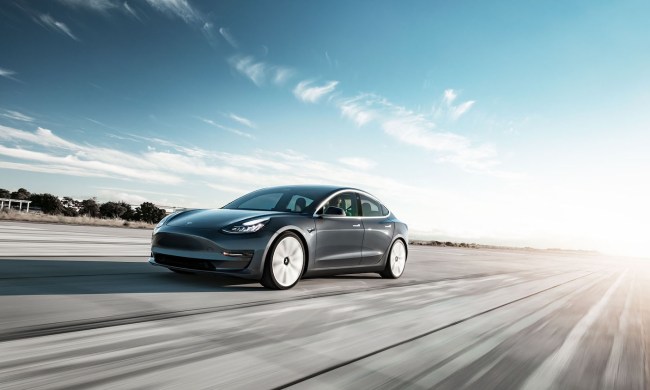There are legions of analysts predicting that self-driving cars are the future, and several carmakers and tech companies looking to make that prediction come true.
Companies like Nissan and Tesla hope to have cars with limited self-driving capability out before the end of this decade, and many of today’s production cars can already brake themselves, steer themselves back into a lane, or follow traffic without human guidance.
Autonomous vehicles are quickly advancing past the “how” stage, which may invite questions that are tougher than figuring out how to give a robot a driver’s license.
Mercedes-Benz is among the cadre of automakers that is working on a self-driving car, and this week it took the technology to another level with the unveiling of the Future Truck 2025, a self-driving semi.
The Future Truck points to a scenario where the majority of vehicles on the road are automated, but what will that be like, or will it not happen in the first place? Despite the confidence expressed by Mercedes and others, it may be a bit early to put a down payment on that self-driving car.
Technological slow lane
There’s a reason why Mercedes’ flashy concept truck has the date “2025” in its name. It will likely take even more than the 11 years between now and then for heavy-duty trucks to go autonomous.
Unlike with passenger cars, manufacturers can’t rely on early adopters to get the general public used to a technology and act as beta testers.
Truck owners and fleet operators need their vehicles to make money, they’re not swayed by style or the need to be the first with the latest technology. They’re also typically hesitant to invest in more-expensive equipment without proof that it will pay for itself in lower operating costs.
So truckers aren’t the ideal customers for new technology like a self-driving vehicle, and that shows just how far into the future Mercedes is looking with its Future Truck.
 Silicon highway
Silicon highway
Before big rigs start driving themselves, there will likely be successive waves of self-driving passenger cars. Like the current crop of modern electric cars, that will include a first generation of models that may not make a big sales impact, but will get people thinking about the consequences of a different type of motoring.
In other words, by why bother with self-driving cars in the first place?
One of the benefits of self-driving cars will be increased free time. At least some people envision spending their entire morning commute playing with their smartphones, which may be why Google is so interested in autonomous vehicles.
Related: Self-driving cars: Far-flung future, or almost here?
However, there could be less-frivolous benefits as well.
Trucking companies probably won’t want to encourage their employees to text while on the job, but they will appreciate the increased safety of self-driving vehicles. Machines are simply more predictable than humans.
With its array of cameras and sensors, the Future Truck unblinkingly watches its surroundings, and can even read traffic signs. Never wavering from a preset speed, it could also save fuel through more-efficient driving.
Robot apocalypse?
Safety and fuel economy are good reasons to drive (no pun intended) manufacturers and consumers to self-driving vehicles, but that first generation of production models may also run into problems that could keep the Mercedes Future Truck off the road.
Before people can be comfortable with massive 18-wheelers being driven by machines, they’ll have to get used to ordinary cars driving themselves, and that’s proving difficult.
Because while autonomous vehicles are supposed to virtually eliminate crashes, even the most reliable machine can fail.
What happens when the first self-driving car crash occurs is still unknown. With no human involvement, faulty equipment would logically be the cause. That’s a problem for carmakers and parts suppliers, who will suddenly be opened up to massive liability risk.
For now, lawmakers are being cautious. California and Nevada permit self-driving car testing on public roads, but California specifically requires a steering wheel and brake as backups.
Hands on the wheel
If self-driving cars do make it to production, don’t expect that steering wheel to go anywhere.
Some human control will probably be necessary for the foreseeable future in case of emergencies. A faulty machine is one thing, but letting it potentially careen out of control with helpless passengers inside is another.
That’s why Toyota recently announced that it won’t pursue a fully-autonomous car, it feels humans should be kept in the loop. Conversely, it may also be why other carmakers are doling out asterisks.
Tesla refers to the technology it’s developing as an “autopilot,” while Nissan acknowledges that the autonomous car it’s planning for 2020 will still require some human control.
Just like airliners with autopilot, it’s more than likely that the Mercedes Future Truck would rely heavily on a human operator as well.
 Conclusion
Conclusion
All of these legal and ethical issues stand in the way of a future where both cars and trucks can drive themselves.
Rules and feelings may seem inconsequential next to the grand technological achievement of a self-driving car or truck, but just because something can be made doesn’t mean it will.
Even supporters of this tech should consider that self-driving vehicles won’t have a major impact unless they’re adopted on a massive scale.
The safety and efficiency benefits of autonomous vehicles will be erased if the majority of people are still driving themselves, wasting fuel, and eyeing their phones.
Range anxiety and other issues are still hindering adoption of electric cars, but at least they feel largely “normal.” How long will it take for consumers to make the much bigger leap to self-driving cars?
Even if they can be built, people’s desire to remain in control may cause motoring’s autonomous future to stall before it even leaves the driveway.




